Literature Review: Employee Motivation and Organizational Performance
VerifiedAdded on 2023/04/05
|8
|1476
|454
Literature Review
AI Summary
This literature review examines the critical link between employee motivation and organizational performance, drawing insights from two key academic articles. The review begins by introducing the importance of employee engagement in fostering optimal organizational outcomes. The first article, by Barrick et al. (2015), explores how collective organizational engagement can be enhanced through motivational work designs, effective human resource management practices, and transformational leadership. The article emphasizes the resource-based view, highlighting the importance of aligning departmental and organizational goals. The second article, by Singh (2016), delves into the significance of intrinsic and extrinsic motivators in driving employee engagement. It discusses various factors influencing employee motivation, including financial rewards, recognition, and the application of motivational theories such as those proposed by Maslow and Herzberg. The review critically assesses the strengths and weaknesses of each article, including the limitations of the resource-based theory and the cultural variations in motivational factors. It concludes by emphasizing the need for organizations to implement effective motivational techniques to enhance employee engagement and, consequently, improve overall performance. The review underscores the importance of strategic alignment, effective resource management, and a nuanced understanding of motivational factors to foster a high-performing work environment.
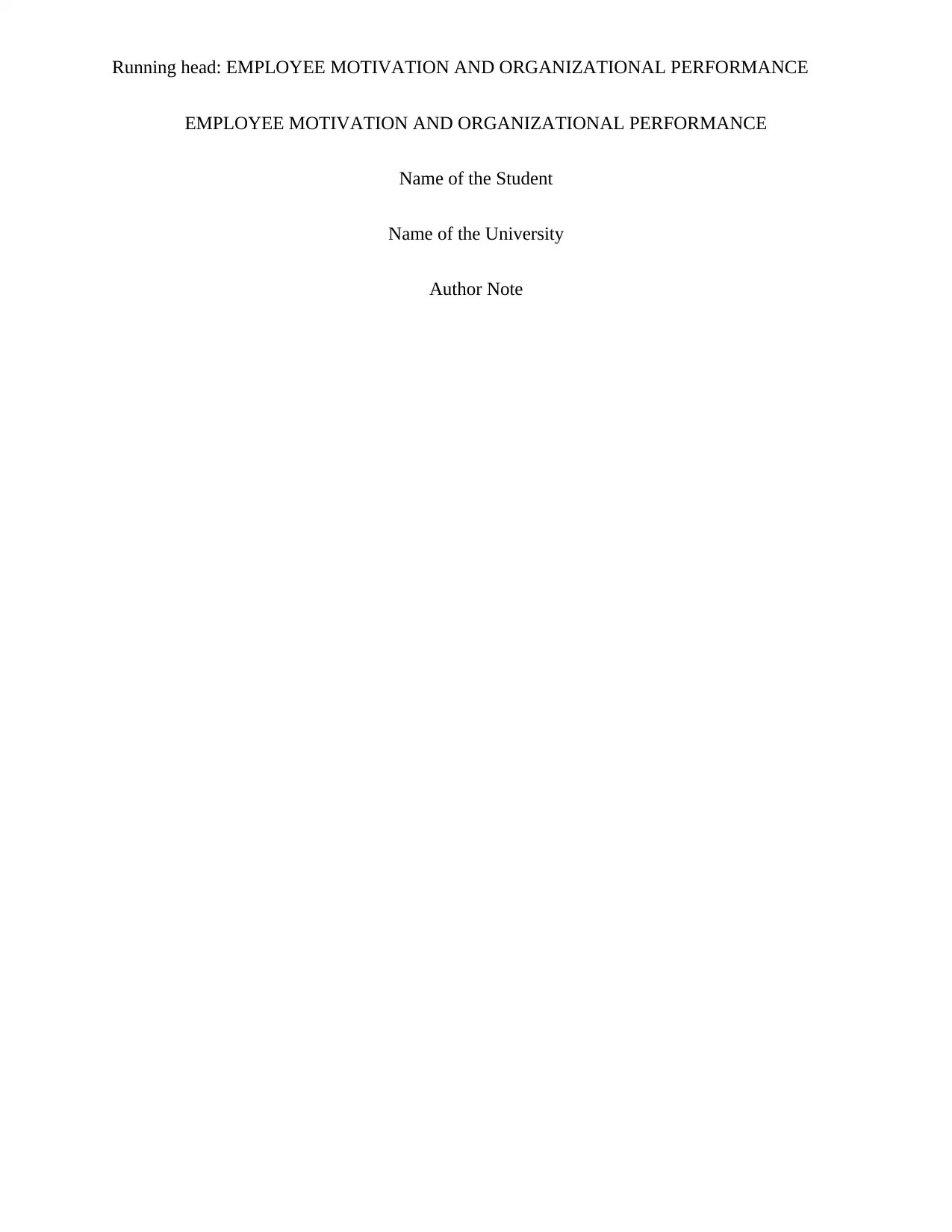
Running head: EMPLOYEE MOTIVATION AND ORGANIZATIONAL PERFORMANCE
EMPLOYEE MOTIVATION AND ORGANIZATIONAL PERFORMANCE
Name of the Student
Name of the University
Author Note
EMPLOYEE MOTIVATION AND ORGANIZATIONAL PERFORMANCE
Name of the Student
Name of the University
Author Note
Paraphrase This Document
Need a fresh take? Get an instant paraphrase of this document with our AI Paraphraser
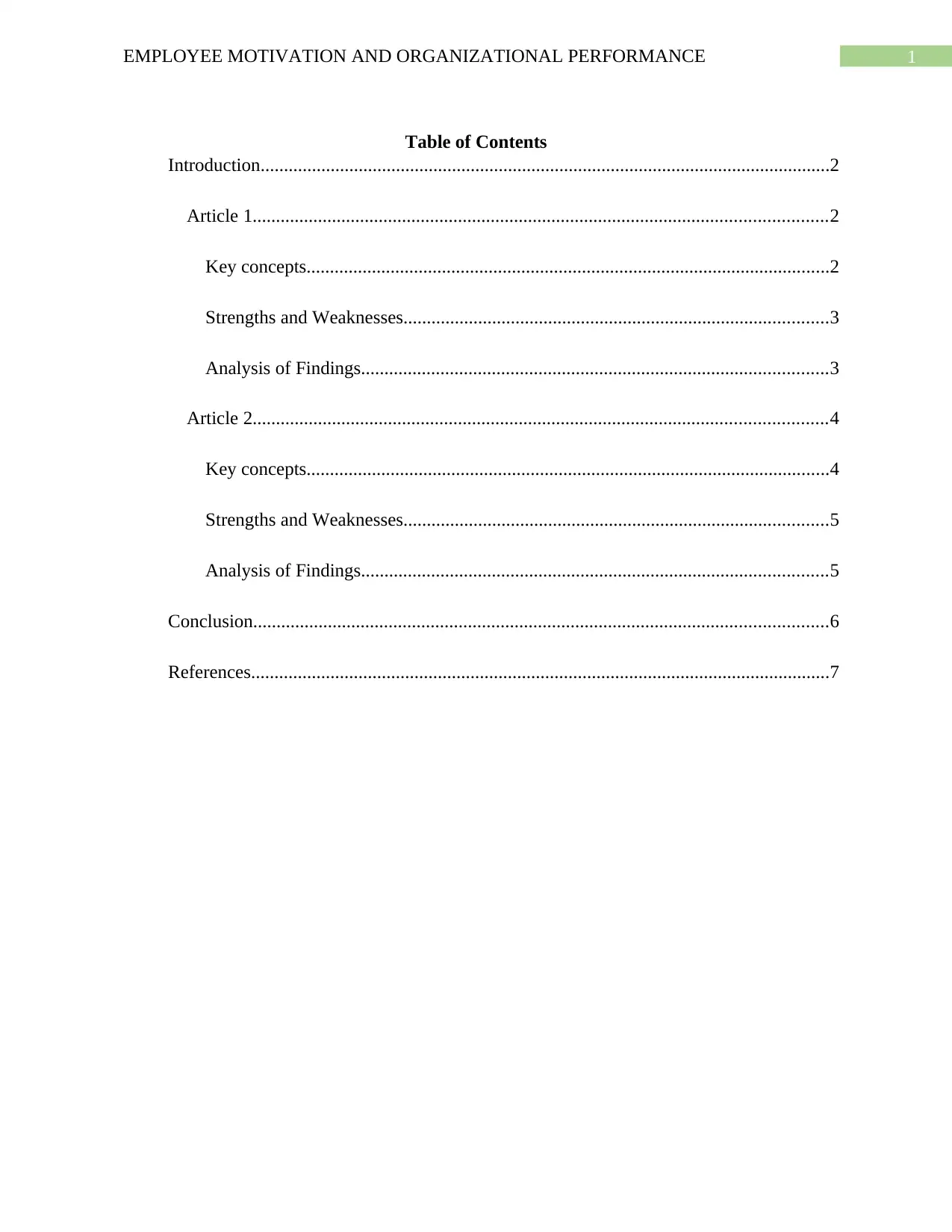
1EMPLOYEE MOTIVATION AND ORGANIZATIONAL PERFORMANCE
Table of Contents
Introduction..........................................................................................................................2
Article 1...........................................................................................................................2
Key concepts................................................................................................................2
Strengths and Weaknesses...........................................................................................3
Analysis of Findings....................................................................................................3
Article 2...........................................................................................................................4
Key concepts................................................................................................................4
Strengths and Weaknesses...........................................................................................5
Analysis of Findings....................................................................................................5
Conclusion...........................................................................................................................6
References............................................................................................................................7
Table of Contents
Introduction..........................................................................................................................2
Article 1...........................................................................................................................2
Key concepts................................................................................................................2
Strengths and Weaknesses...........................................................................................3
Analysis of Findings....................................................................................................3
Article 2...........................................................................................................................4
Key concepts................................................................................................................4
Strengths and Weaknesses...........................................................................................5
Analysis of Findings....................................................................................................5
Conclusion...........................................................................................................................6
References............................................................................................................................7
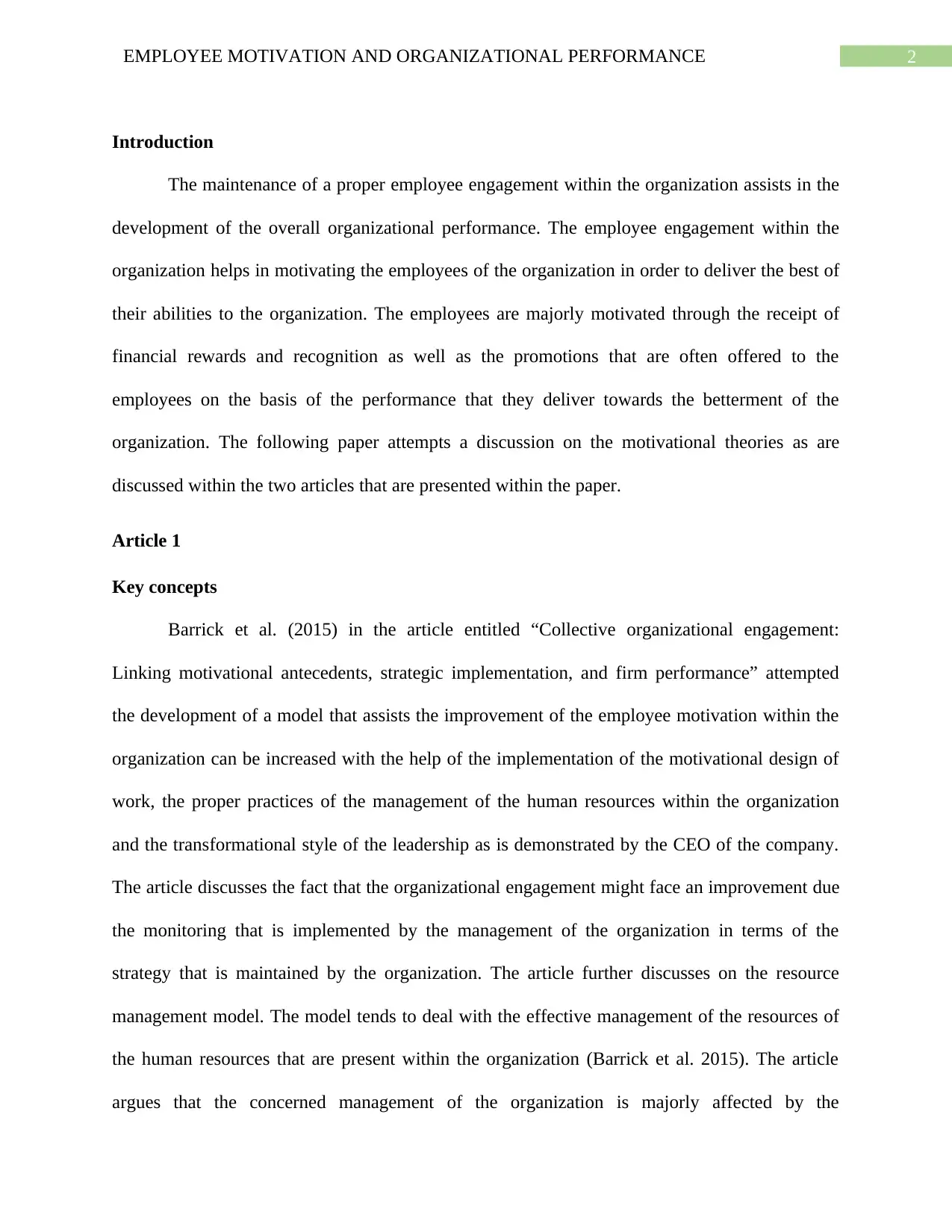
2EMPLOYEE MOTIVATION AND ORGANIZATIONAL PERFORMANCE
Introduction
The maintenance of a proper employee engagement within the organization assists in the
development of the overall organizational performance. The employee engagement within the
organization helps in motivating the employees of the organization in order to deliver the best of
their abilities to the organization. The employees are majorly motivated through the receipt of
financial rewards and recognition as well as the promotions that are often offered to the
employees on the basis of the performance that they deliver towards the betterment of the
organization. The following paper attempts a discussion on the motivational theories as are
discussed within the two articles that are presented within the paper.
Article 1
Key concepts
Barrick et al. (2015) in the article entitled “Collective organizational engagement:
Linking motivational antecedents, strategic implementation, and firm performance” attempted
the development of a model that assists the improvement of the employee motivation within the
organization can be increased with the help of the implementation of the motivational design of
work, the proper practices of the management of the human resources within the organization
and the transformational style of the leadership as is demonstrated by the CEO of the company.
The article discusses the fact that the organizational engagement might face an improvement due
the monitoring that is implemented by the management of the organization in terms of the
strategy that is maintained by the organization. The article further discusses on the resource
management model. The model tends to deal with the effective management of the resources of
the human resources that are present within the organization (Barrick et al. 2015). The article
argues that the concerned management of the organization is majorly affected by the
Introduction
The maintenance of a proper employee engagement within the organization assists in the
development of the overall organizational performance. The employee engagement within the
organization helps in motivating the employees of the organization in order to deliver the best of
their abilities to the organization. The employees are majorly motivated through the receipt of
financial rewards and recognition as well as the promotions that are often offered to the
employees on the basis of the performance that they deliver towards the betterment of the
organization. The following paper attempts a discussion on the motivational theories as are
discussed within the two articles that are presented within the paper.
Article 1
Key concepts
Barrick et al. (2015) in the article entitled “Collective organizational engagement:
Linking motivational antecedents, strategic implementation, and firm performance” attempted
the development of a model that assists the improvement of the employee motivation within the
organization can be increased with the help of the implementation of the motivational design of
work, the proper practices of the management of the human resources within the organization
and the transformational style of the leadership as is demonstrated by the CEO of the company.
The article discusses the fact that the organizational engagement might face an improvement due
the monitoring that is implemented by the management of the organization in terms of the
strategy that is maintained by the organization. The article further discusses on the resource
management model. The model tends to deal with the effective management of the resources of
the human resources that are present within the organization (Barrick et al. 2015). The article
argues that the concerned management of the organization is majorly affected by the
⊘ This is a preview!⊘
Do you want full access?
Subscribe today to unlock all pages.

Trusted by 1+ million students worldwide
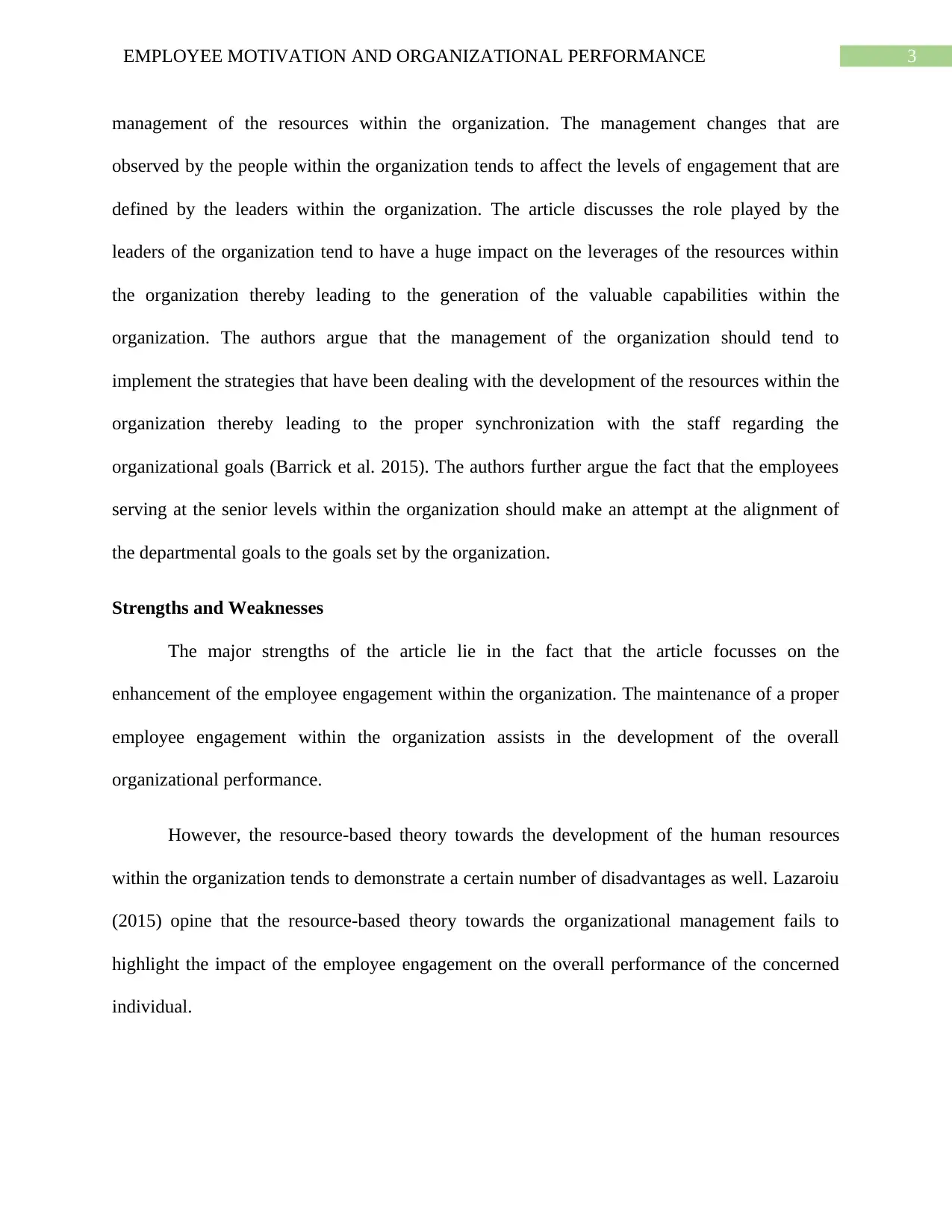
3EMPLOYEE MOTIVATION AND ORGANIZATIONAL PERFORMANCE
management of the resources within the organization. The management changes that are
observed by the people within the organization tends to affect the levels of engagement that are
defined by the leaders within the organization. The article discusses the role played by the
leaders of the organization tend to have a huge impact on the leverages of the resources within
the organization thereby leading to the generation of the valuable capabilities within the
organization. The authors argue that the management of the organization should tend to
implement the strategies that have been dealing with the development of the resources within the
organization thereby leading to the proper synchronization with the staff regarding the
organizational goals (Barrick et al. 2015). The authors further argue the fact that the employees
serving at the senior levels within the organization should make an attempt at the alignment of
the departmental goals to the goals set by the organization.
Strengths and Weaknesses
The major strengths of the article lie in the fact that the article focusses on the
enhancement of the employee engagement within the organization. The maintenance of a proper
employee engagement within the organization assists in the development of the overall
organizational performance.
However, the resource-based theory towards the development of the human resources
within the organization tends to demonstrate a certain number of disadvantages as well. Lazaroiu
(2015) opine that the resource-based theory towards the organizational management fails to
highlight the impact of the employee engagement on the overall performance of the concerned
individual.
management of the resources within the organization. The management changes that are
observed by the people within the organization tends to affect the levels of engagement that are
defined by the leaders within the organization. The article discusses the role played by the
leaders of the organization tend to have a huge impact on the leverages of the resources within
the organization thereby leading to the generation of the valuable capabilities within the
organization. The authors argue that the management of the organization should tend to
implement the strategies that have been dealing with the development of the resources within the
organization thereby leading to the proper synchronization with the staff regarding the
organizational goals (Barrick et al. 2015). The authors further argue the fact that the employees
serving at the senior levels within the organization should make an attempt at the alignment of
the departmental goals to the goals set by the organization.
Strengths and Weaknesses
The major strengths of the article lie in the fact that the article focusses on the
enhancement of the employee engagement within the organization. The maintenance of a proper
employee engagement within the organization assists in the development of the overall
organizational performance.
However, the resource-based theory towards the development of the human resources
within the organization tends to demonstrate a certain number of disadvantages as well. Lazaroiu
(2015) opine that the resource-based theory towards the organizational management fails to
highlight the impact of the employee engagement on the overall performance of the concerned
individual.
Paraphrase This Document
Need a fresh take? Get an instant paraphrase of this document with our AI Paraphraser
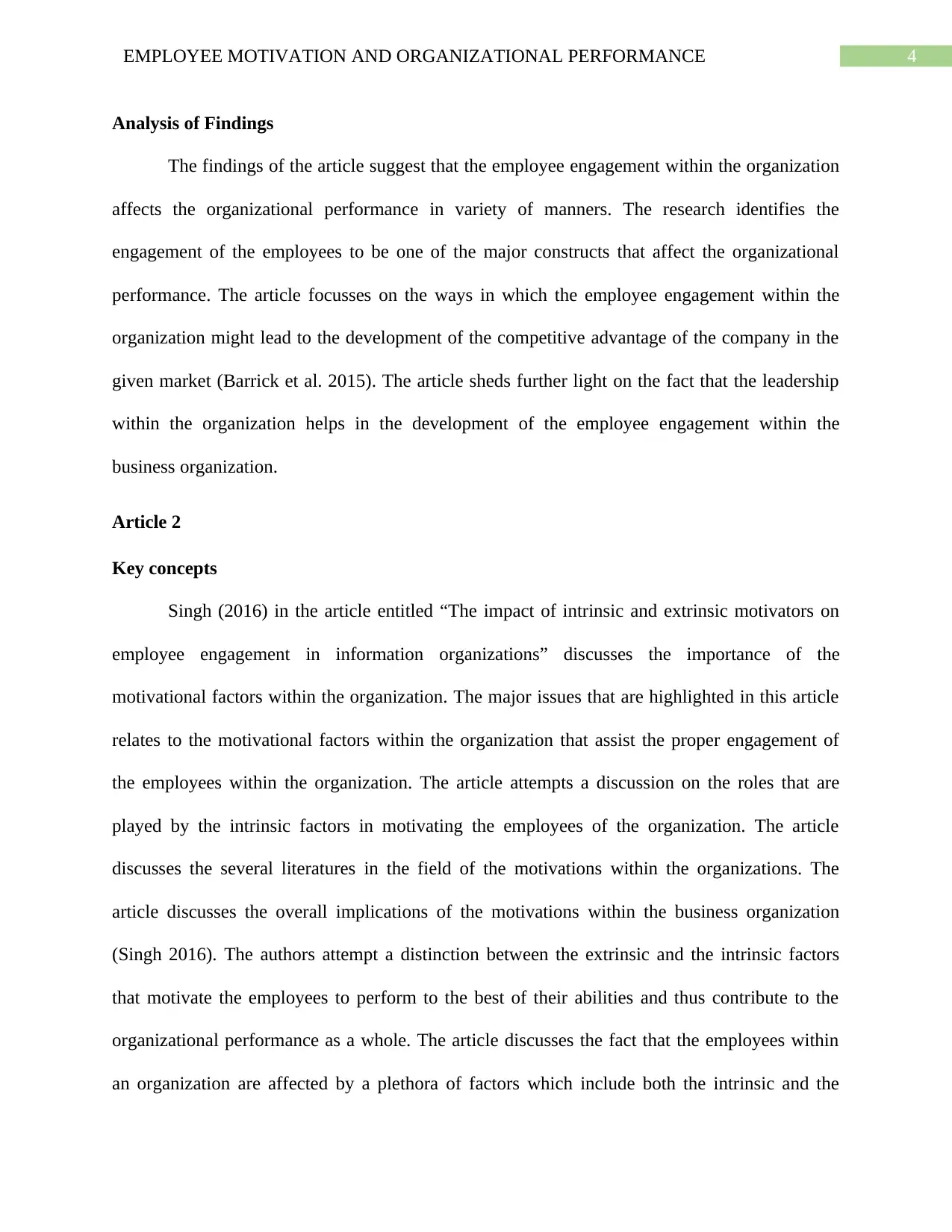
4EMPLOYEE MOTIVATION AND ORGANIZATIONAL PERFORMANCE
Analysis of Findings
The findings of the article suggest that the employee engagement within the organization
affects the organizational performance in variety of manners. The research identifies the
engagement of the employees to be one of the major constructs that affect the organizational
performance. The article focusses on the ways in which the employee engagement within the
organization might lead to the development of the competitive advantage of the company in the
given market (Barrick et al. 2015). The article sheds further light on the fact that the leadership
within the organization helps in the development of the employee engagement within the
business organization.
Article 2
Key concepts
Singh (2016) in the article entitled “The impact of intrinsic and extrinsic motivators on
employee engagement in information organizations” discusses the importance of the
motivational factors within the organization. The major issues that are highlighted in this article
relates to the motivational factors within the organization that assist the proper engagement of
the employees within the organization. The article attempts a discussion on the roles that are
played by the intrinsic factors in motivating the employees of the organization. The article
discusses the several literatures in the field of the motivations within the organizations. The
article discusses the overall implications of the motivations within the business organization
(Singh 2016). The authors attempt a distinction between the extrinsic and the intrinsic factors
that motivate the employees to perform to the best of their abilities and thus contribute to the
organizational performance as a whole. The article discusses the fact that the employees within
an organization are affected by a plethora of factors which include both the intrinsic and the
Analysis of Findings
The findings of the article suggest that the employee engagement within the organization
affects the organizational performance in variety of manners. The research identifies the
engagement of the employees to be one of the major constructs that affect the organizational
performance. The article focusses on the ways in which the employee engagement within the
organization might lead to the development of the competitive advantage of the company in the
given market (Barrick et al. 2015). The article sheds further light on the fact that the leadership
within the organization helps in the development of the employee engagement within the
business organization.
Article 2
Key concepts
Singh (2016) in the article entitled “The impact of intrinsic and extrinsic motivators on
employee engagement in information organizations” discusses the importance of the
motivational factors within the organization. The major issues that are highlighted in this article
relates to the motivational factors within the organization that assist the proper engagement of
the employees within the organization. The article attempts a discussion on the roles that are
played by the intrinsic factors in motivating the employees of the organization. The article
discusses the several literatures in the field of the motivations within the organizations. The
article discusses the overall implications of the motivations within the business organization
(Singh 2016). The authors attempt a distinction between the extrinsic and the intrinsic factors
that motivate the employees to perform to the best of their abilities and thus contribute to the
organizational performance as a whole. The article discusses the fact that the employees within
an organization are affected by a plethora of factors which include both the intrinsic and the
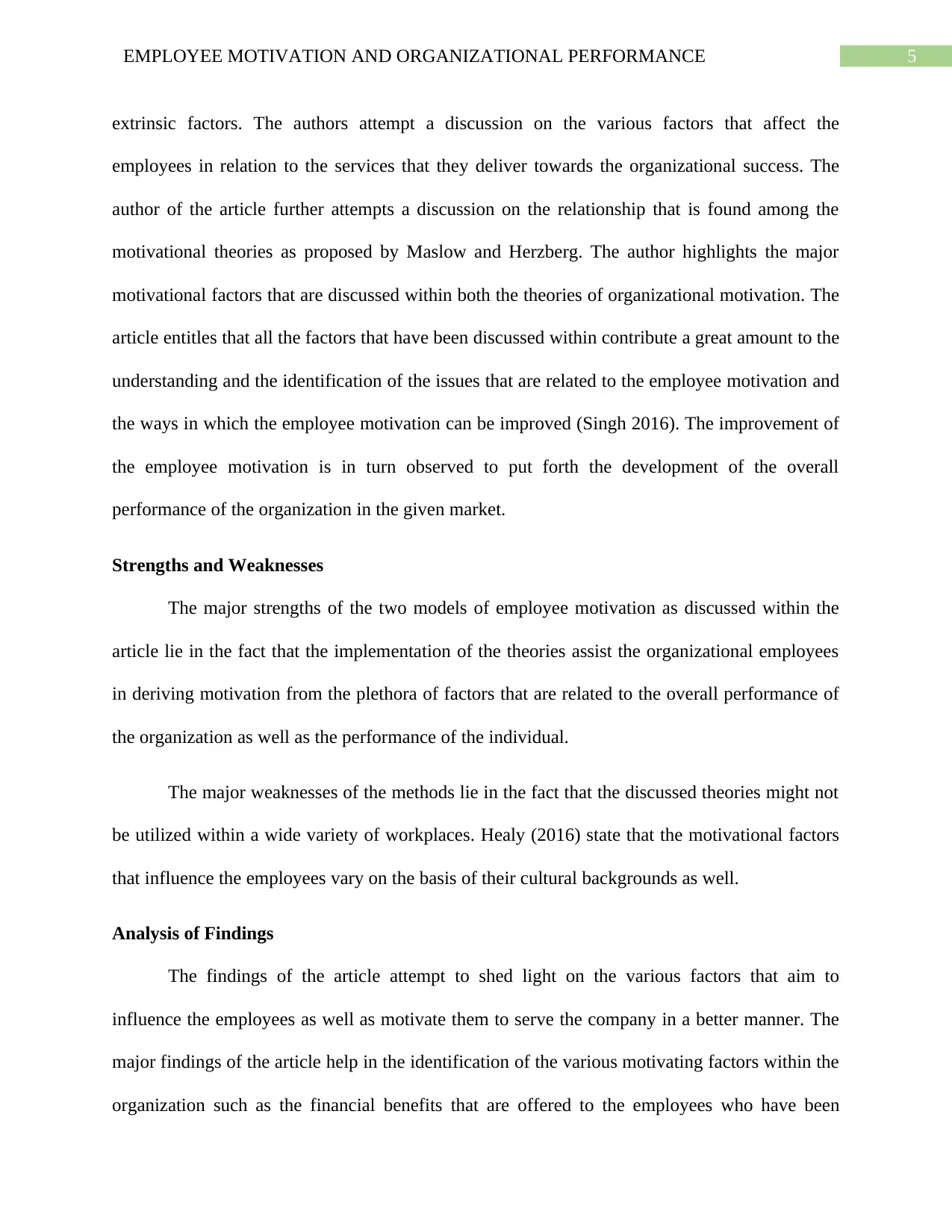
5EMPLOYEE MOTIVATION AND ORGANIZATIONAL PERFORMANCE
extrinsic factors. The authors attempt a discussion on the various factors that affect the
employees in relation to the services that they deliver towards the organizational success. The
author of the article further attempts a discussion on the relationship that is found among the
motivational theories as proposed by Maslow and Herzberg. The author highlights the major
motivational factors that are discussed within both the theories of organizational motivation. The
article entitles that all the factors that have been discussed within contribute a great amount to the
understanding and the identification of the issues that are related to the employee motivation and
the ways in which the employee motivation can be improved (Singh 2016). The improvement of
the employee motivation is in turn observed to put forth the development of the overall
performance of the organization in the given market.
Strengths and Weaknesses
The major strengths of the two models of employee motivation as discussed within the
article lie in the fact that the implementation of the theories assist the organizational employees
in deriving motivation from the plethora of factors that are related to the overall performance of
the organization as well as the performance of the individual.
The major weaknesses of the methods lie in the fact that the discussed theories might not
be utilized within a wide variety of workplaces. Healy (2016) state that the motivational factors
that influence the employees vary on the basis of their cultural backgrounds as well.
Analysis of Findings
The findings of the article attempt to shed light on the various factors that aim to
influence the employees as well as motivate them to serve the company in a better manner. The
major findings of the article help in the identification of the various motivating factors within the
organization such as the financial benefits that are offered to the employees who have been
extrinsic factors. The authors attempt a discussion on the various factors that affect the
employees in relation to the services that they deliver towards the organizational success. The
author of the article further attempts a discussion on the relationship that is found among the
motivational theories as proposed by Maslow and Herzberg. The author highlights the major
motivational factors that are discussed within both the theories of organizational motivation. The
article entitles that all the factors that have been discussed within contribute a great amount to the
understanding and the identification of the issues that are related to the employee motivation and
the ways in which the employee motivation can be improved (Singh 2016). The improvement of
the employee motivation is in turn observed to put forth the development of the overall
performance of the organization in the given market.
Strengths and Weaknesses
The major strengths of the two models of employee motivation as discussed within the
article lie in the fact that the implementation of the theories assist the organizational employees
in deriving motivation from the plethora of factors that are related to the overall performance of
the organization as well as the performance of the individual.
The major weaknesses of the methods lie in the fact that the discussed theories might not
be utilized within a wide variety of workplaces. Healy (2016) state that the motivational factors
that influence the employees vary on the basis of their cultural backgrounds as well.
Analysis of Findings
The findings of the article attempt to shed light on the various factors that aim to
influence the employees as well as motivate them to serve the company in a better manner. The
major findings of the article help in the identification of the various motivating factors within the
organization such as the financial benefits that are offered to the employees who have been
⊘ This is a preview!⊘
Do you want full access?
Subscribe today to unlock all pages.

Trusted by 1+ million students worldwide
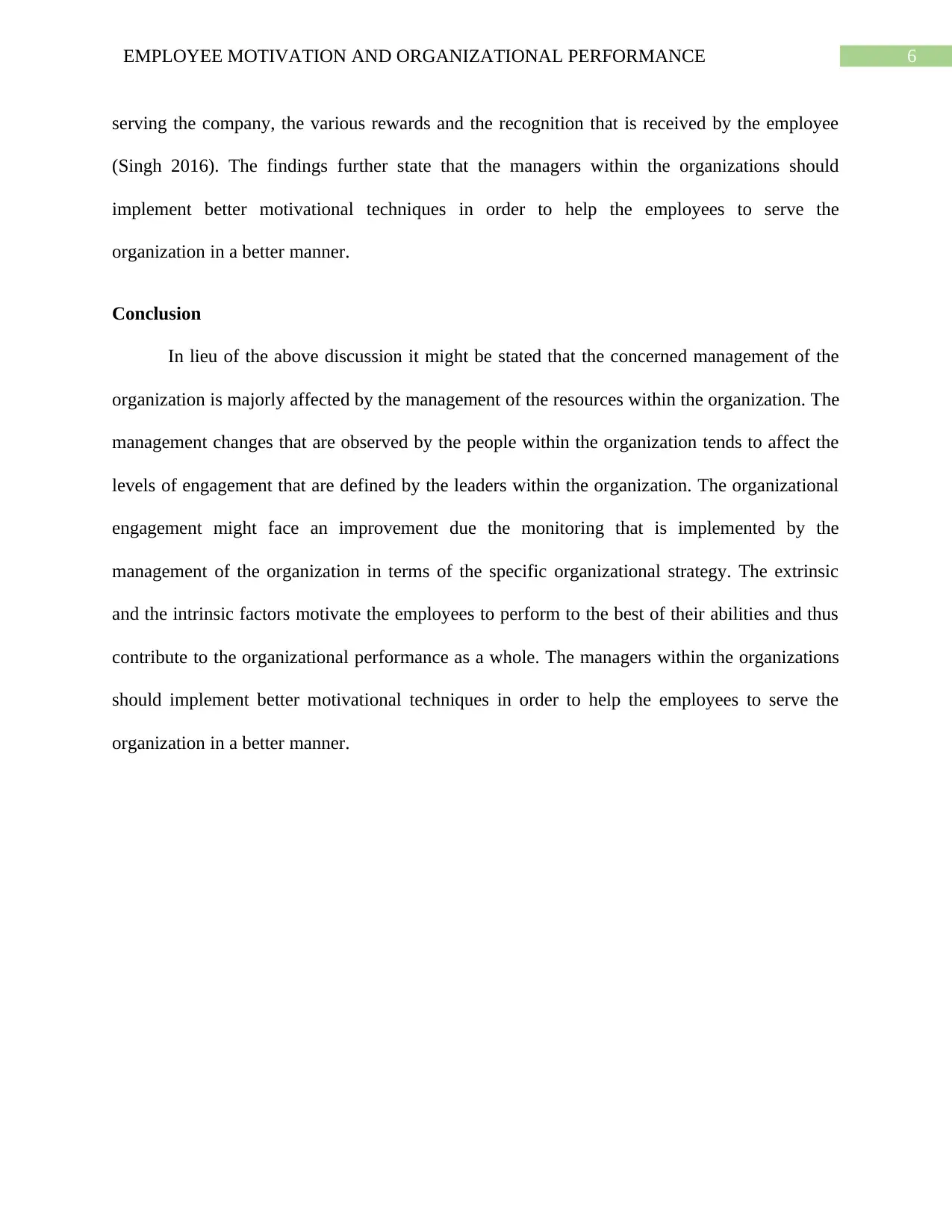
6EMPLOYEE MOTIVATION AND ORGANIZATIONAL PERFORMANCE
serving the company, the various rewards and the recognition that is received by the employee
(Singh 2016). The findings further state that the managers within the organizations should
implement better motivational techniques in order to help the employees to serve the
organization in a better manner.
Conclusion
In lieu of the above discussion it might be stated that the concerned management of the
organization is majorly affected by the management of the resources within the organization. The
management changes that are observed by the people within the organization tends to affect the
levels of engagement that are defined by the leaders within the organization. The organizational
engagement might face an improvement due the monitoring that is implemented by the
management of the organization in terms of the specific organizational strategy. The extrinsic
and the intrinsic factors motivate the employees to perform to the best of their abilities and thus
contribute to the organizational performance as a whole. The managers within the organizations
should implement better motivational techniques in order to help the employees to serve the
organization in a better manner.
serving the company, the various rewards and the recognition that is received by the employee
(Singh 2016). The findings further state that the managers within the organizations should
implement better motivational techniques in order to help the employees to serve the
organization in a better manner.
Conclusion
In lieu of the above discussion it might be stated that the concerned management of the
organization is majorly affected by the management of the resources within the organization. The
management changes that are observed by the people within the organization tends to affect the
levels of engagement that are defined by the leaders within the organization. The organizational
engagement might face an improvement due the monitoring that is implemented by the
management of the organization in terms of the specific organizational strategy. The extrinsic
and the intrinsic factors motivate the employees to perform to the best of their abilities and thus
contribute to the organizational performance as a whole. The managers within the organizations
should implement better motivational techniques in order to help the employees to serve the
organization in a better manner.
Paraphrase This Document
Need a fresh take? Get an instant paraphrase of this document with our AI Paraphraser
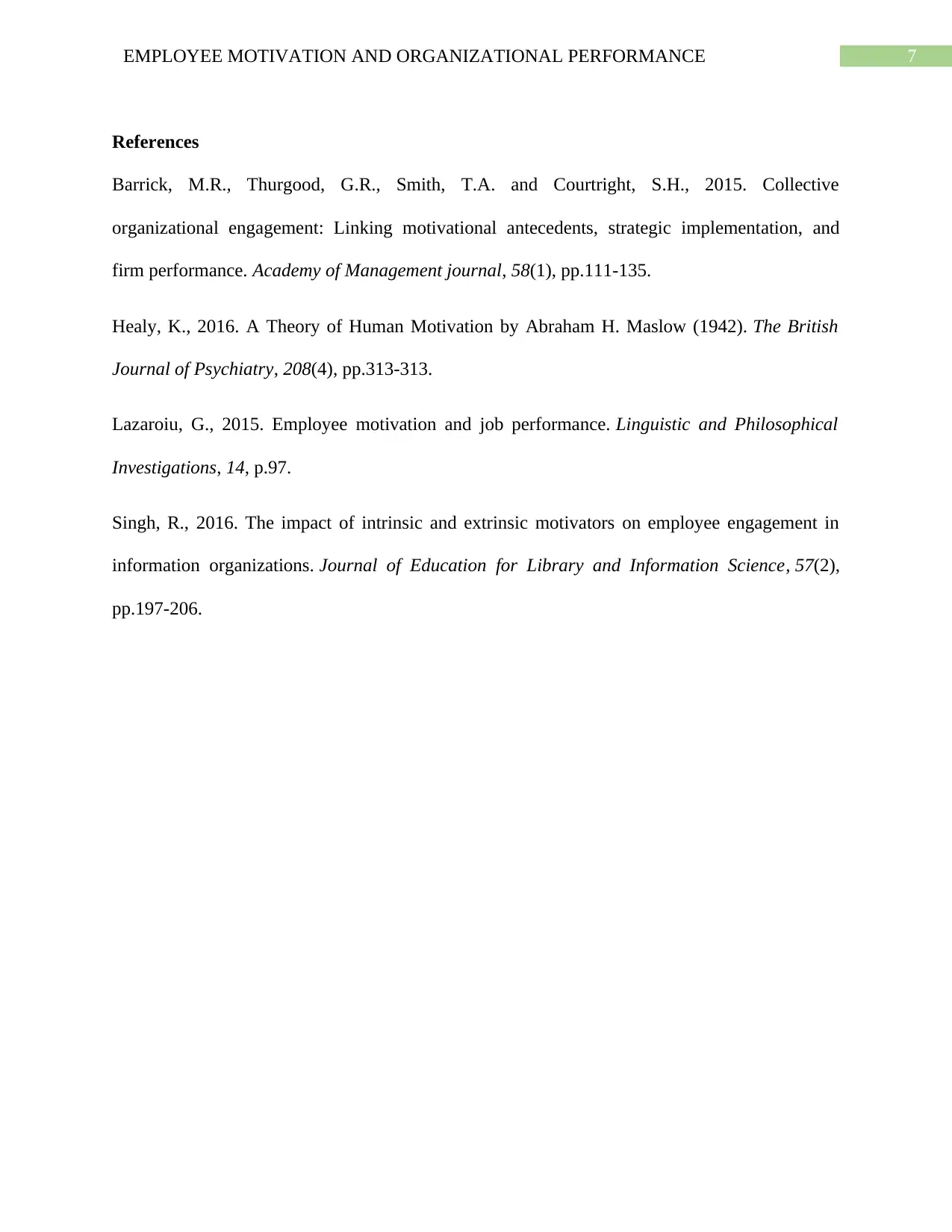
7EMPLOYEE MOTIVATION AND ORGANIZATIONAL PERFORMANCE
References
Barrick, M.R., Thurgood, G.R., Smith, T.A. and Courtright, S.H., 2015. Collective
organizational engagement: Linking motivational antecedents, strategic implementation, and
firm performance. Academy of Management journal, 58(1), pp.111-135.
Healy, K., 2016. A Theory of Human Motivation by Abraham H. Maslow (1942). The British
Journal of Psychiatry, 208(4), pp.313-313.
Lazaroiu, G., 2015. Employee motivation and job performance. Linguistic and Philosophical
Investigations, 14, p.97.
Singh, R., 2016. The impact of intrinsic and extrinsic motivators on employee engagement in
information organizations. Journal of Education for Library and Information Science, 57(2),
pp.197-206.
References
Barrick, M.R., Thurgood, G.R., Smith, T.A. and Courtright, S.H., 2015. Collective
organizational engagement: Linking motivational antecedents, strategic implementation, and
firm performance. Academy of Management journal, 58(1), pp.111-135.
Healy, K., 2016. A Theory of Human Motivation by Abraham H. Maslow (1942). The British
Journal of Psychiatry, 208(4), pp.313-313.
Lazaroiu, G., 2015. Employee motivation and job performance. Linguistic and Philosophical
Investigations, 14, p.97.
Singh, R., 2016. The impact of intrinsic and extrinsic motivators on employee engagement in
information organizations. Journal of Education for Library and Information Science, 57(2),
pp.197-206.
1 out of 8
Related Documents
Your All-in-One AI-Powered Toolkit for Academic Success.
+13062052269
info@desklib.com
Available 24*7 on WhatsApp / Email
![[object Object]](/_next/static/media/star-bottom.7253800d.svg)
Unlock your academic potential
Copyright © 2020–2025 A2Z Services. All Rights Reserved. Developed and managed by ZUCOL.





